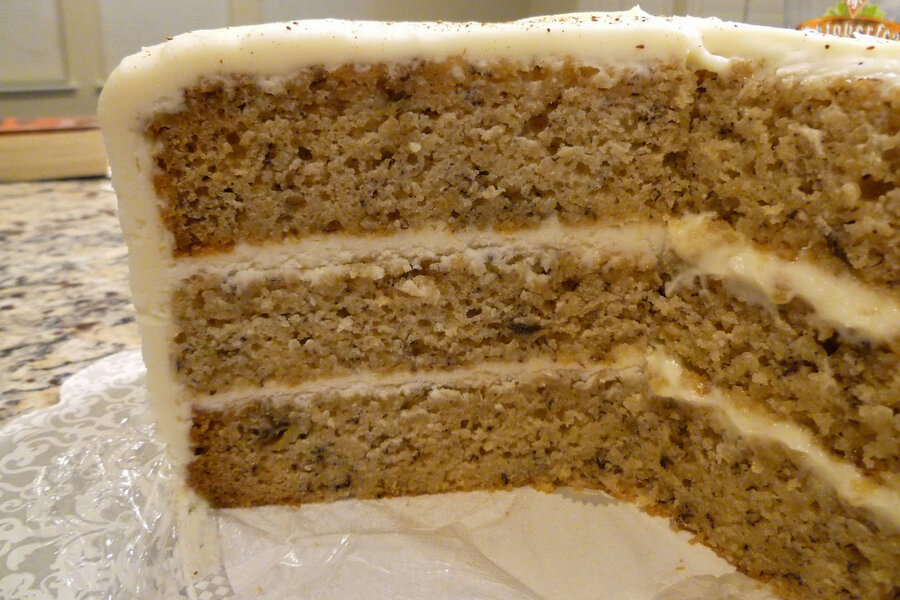Banana dream cake
Loading...
Over the past few years I've talked intermittently about my love for the banana cake from Icing on the Cake from a bakery in Los Gatos, Calif. I go there every year around my birthday and buy myself a piece as my birthday cake. There's a hiking trail near there that I sometimes go to and, after a long hike, I have no problem justifying a stop at Icing on the Cake to get my favorite slice (good thing they sell it by the piece). I've even built into my pre-retirement, post-corporate America plans that I'm going to apply for a baking job there just so I could learn how they make their banana cake.
I've tried endless recipes of different banana cakes to replicate it. There have been a few where I've come close on taste but not on the fluffy texture. Most banana cakes I've made have been too moist or too dense or both. The fluffy has eluded me. So when I saw the picture of this cake from The Novice Chef, hope sprang eternal again as the pictured cake looked close to my Holy Grail of banana cakes. Could this be it? Could this be the one?
Just by looking at the original recipe, here are a few things I knew right off the bat before I even baked it: this would be moist, not just from the amount of liquid ingredients (the milk) but also from the sour cream. It would not taste lemony even though there's lemon juice in it. The acidity of the lemon juice is needed to activate the baking soda and add to the leavening of the cake. It would not likely be greasy because the applesauce allows for a smaller amount of butter to be used. I actually thought it might not be banana-y enough because a cup of bananas didn't seem like much for a three-layer cake. I admit I erred on the side of banana and added a generous cup of it. Beyond that, I followed the recipe to a T. Final result? This was so close to the cake texture I was looking for. Close. Really close. But not quite. And still not as fluffy as what was pictured on The Novice Chef.
However, it did set my baking wheels turning. With a few tweaks, I felt sure I could come even closer. The first thing I had to accept is: It is not the recipe that makes the cake. Or at least not just the recipe ingredients. It's the technique. This was a great recipe to start with but I had to make some adjustments. First, remember that bananas add a lot of moisture to a cake. More moisture means denser cake if you don't compensate with additional baking time. I'm always terrified of overbaking so I underbake more often than not. And that's a big part of my problem.
But let's tackle one problem at a time. Because I use very, very overripe bananas, flavor wasn't going to be an issue if I used a little less banana. Instead of a generous cup, I used a scant cup. So not as much moisture going in. Second, to achieve a fluffy texture, the batter has to have more air beaten into it. I don't like to overmix batter because that'll develop the gluten from the flour and make the texture tough. So the time to beat more air into the batter is before you add the flour. It's also before you add the eggs. If you overbeat batter with eggs in it, you inadvertently can make a meringue texture from the foaminess of the eggs and get a crust on top. So the time to beat air into the batter is when you're creaming the butter and the sugar together. Most recipes say to beat until "light and fluffy" but that leaves so much room for interpretation and I often interpret that incorrectly. This time I beat it a little longer than I normally do. I normally only beat for a minute, this time I beat for 3 minutes.
Finally, my biggest weakness – baking time. With this cake, it was actually hard to tell when it was done because the toothpick did come out "clean" so you'd think it was done. But while it wasn't too underbaked the first time, I knew I could've baked it a little longer and that would've been a huge factor in getting the fluffy texture I've been obsessively looking for. The second time around, I factored in not just whether the toothpick came out clean, but also how easily it went in. A denser cake will provide more resistance while a more baked cake will let the toothpick go in more easily. It's hard to describe unless you have a comparison at the same time, but I've been a Monday morning quarterback for a lot of underbaked cakes so my baking instincts can usually tell me when something needs to stay in the oven a little longer. I just usually second guess myself and ignore those instincts, but this time I muffled my baking insecurities and just let the cake layers bake. And bake.
Result of the second cake? Still close, but still not quite right. Sigh. I thought I was on the right track, but I don't think my changes made a discernible difference in the fluffiness. And, one of my coworkers confessed she liked the first cake better than the second cake. But no experiment is wasted. Now my baking wheels keep on churning on the next things to test. I think I need a recipe that uses cake flour (lighter texture) as well as baking powder (more leavening). So the search continues and my pre-retirement plans to work at Icing on the Cake still remains on my bucket list.
Banana dream cake
Adapted from The Novice Chef
1 scant cup mashed overripe bananas (2-3 bananas)
2 teaspoons lemon juice
3 cups all-purpose flour
1-1/2 teaspoons baking soda
1/4 teaspoon salt
3/4 cup unsalted butter
2 1/8 cups granulated sugar
3 eggs
2 teaspoons vanilla extract
1 cup milk
1/2 cup sour cream
4 ounces applesauce
Frosting
3/4 cup unsalted butter, softened
1-1/2 packages (12 ounces) cream cheese, softened
5-3/4 cups confectioners' sugar
2 teaspoons vanilla extract
Cinnamon, for sprinkling
1. Preheat oven to 275 degrees F. Spray 3 round 8-inch cake pans with nonstick cooking spray and line with parchment rounds.
2. In a medium bowl, mix flour, baking soda, and salt; set aside.
3. In a large bowl, cream butter and sugar together until light and fluffy. Beat in the eggs, one at a time, then stir in vanilla, sour cream, and applesauce. Beat in the flour mixture alternately with the milk. Stir in banana mixture.
4. Divide batter (about 2-1/2 cups batter in each pan) into prepared pans. Bake for 40-50 minutes, or until a toothpick inserted into the center of the cake comes out clean. Remove pans from oven and immediately place in freezer for 45 minutes. This keeps the cake moist by immediately stopping the baking so the cake does not continue to bake when you remove it from the oven. Note: I skipped the freezer step because I didn't have room in my freezer; instead, I ran a spatula around the sides of the cake and overturned them onto plates lined with wax paper as soon as I took them out of the oven to stop the baking from the heat of the pans.
5. For the frosting: In a large bowl, cream butter and cream cheese until smooth. Beat in vanilla.
6. Add confectioners' sugar and beat on low speed until combined, then on high until frosting is smooth.
7. Assemble the three layers with a thick layer of frosting in between each layer. Then apply a thin crumb coat on the top and sides. Place in the refrigerator to harden the crumb coat for 10 minutes. Then apply a thick, even layer around the outside of the cake. Sprinkle on a little cinnamon on top and store in the refrigerator until ready to serve.








